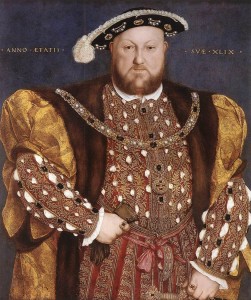 At Whitehall Palace, on 28th January 1547, in the early hours of the morning, a dying Henry VIII squeezed his Archbishop’s hand, giving him the only sign that he could that he trusted in God. He then lapsed into unconsciousness and died. He had reigned for over 37 years and was succeeded by his nine year-old son, Edward VI.
At Whitehall Palace, on 28th January 1547, in the early hours of the morning, a dying Henry VIII squeezed his Archbishop’s hand, giving him the only sign that he could that he trusted in God. He then lapsed into unconsciousness and died. He had reigned for over 37 years and was succeeded by his nine year-old son, Edward VI.
His iconic image, from a lost Holbein mural, is recognised throughout the world and he has gone down in history as the man who had six wives and who executed two of them. He provokes strong feelings and has been labelled a tyrant and monster, but there was more to him than that. In my article “Henry VIII – Henry the Great?”, I quoted David Starkey’s wonderful words about the “two Henrys”, the paradox which is Henry VIII:
“Holbein’s Henry is the king of his last dozen or so years, when he was – in Charles Dickens-s glorious phrase – a spot of blood and grease on the history of England. This is the hulking tyrant with a face like Humpty Dumpty of nightmare, who broke with Rome and made himself supreme head of the church; who married six wives, of whom he divorced two and divorced and executed two others; who dissolved six hundred monasteries; demolished most of them and shattered the religious pieties and practices of a thousand years; who beheaded nobles and ministers, including those who had been his closest friends, castrated, disembowelled and quartered rebels and traitors, boiled poisoners and burned heretics
This is also the king who reinvented England; presided over the remaking of English as a language and literature and began to turn the English Channel into the widest strip of water in the world. He carried the powers of the English monarchy to their peak.”
You can read more about Henry VIII’s achievements and legacy in “Henry VIII – Henry the Great?”.
I will be raising a glass to him today and thinking of the man and his reign.
How can I do that when I believe that he was ultimately responsible for Anne Boleyn’s execution?
Because people are not summed up by one act, however brutal. Too often we think of Henry the tyrant, the man who seemingly entertained Jane Seymour while his wife waited for death, and we forget the charming, intelligent, talented King that Anne Boleyn fell in love with. Whatever your thoughts, he was a fascinating man and I will never bore of reading about him, his wives and his reign. Here’s to Henry VIII!
The King is dead! Long live the King!
You can read more about Henry’s death in the following articles:
And it is also my birthday!
I was born 446 years after the death of King Henry VIII. Fancy that 🙂
Happy Birthday to you!
Also, David Starkey’s documentary, “Henry VIII: Mind of a Tyrant” is a great watch about the life of Henry VIII. I loved it! You can watch it in it’s entirety on Youtube.
Happy birthday! Have a lovely day x
Yes a Happy Bithday Hannah, now we have all worked out you are the lovely age of 20… 🙂 It was mine yesterday, but not giving you a chance to work mine out, it’s a long way from 20 that’s all I’m saying, haha. Have a lovely day.
Happy Birthday Hannah and Belated Happy Birthday Dawn!
well i for one could never understand or even remotely like or admire this excuse for a man.
If we were alive in 1547, maybe we’d have a better understanding of what the times were like. It’s impossible to fathom what it was really like then. Henry is a fascinating part of history, in spite of his narcissism!!
I agree Claire, you can not judge the ‘whole’ man on just one part of his life.
The bad always seems to over shadow the good.
He was a human being with all it’s complexities, with the addition of being a King with absolute power, and absolute power corrupts, so they say.
There are many theories put forward to why he turn into that egotistical, controlling, tyranical King that he is mainly remembered for, but I still think England would have felt a great void when he died, as he undoubtedly created a formidable presence with his huge personality, his glittering court following behind him and his many marital woes.
It certainly seems to make other reigns seem very dull in comparison in some respects, otherwise why would he have this huge following that he inspires through generations and makes us curious about him, his wives, and his court.
But… at the end of the day King or commoner death comes to us all, and not even Henry could have a say in his own mortality.
I hope he is resting in peace that alluded him in his later life, because anyone who behaved as he did in the end was not at all happy or had peace of mind.
The king is dead! Thanks lord haha
I love reading about king henry he did horrible things but also great things and in the times he ruled who could say they would do different he was a man who needed a son and started to open religion and if it wasn’t for him and the things he did it would be a very different world we live in… It would be hard not having a true soul you could trust fully
it is weird that he died exactly 90 years after his father was born on the exact same day